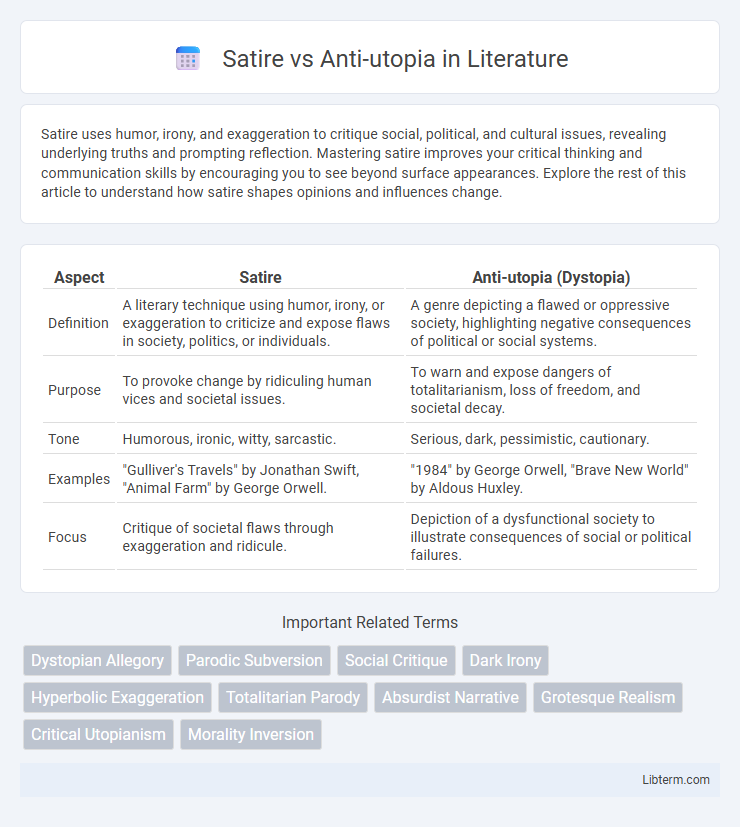Satire uses humor, irony, and exaggeration to critique social, political, and cultural issues, revealing underlying truths and prompting reflection. Mastering satire improves your critical thinking and communication skills by encouraging you to see beyond surface appearances. Explore the rest of this article to understand how satire shapes opinions and influences change.
Table of Comparison
| Aspect | Satire | Anti-utopia (Dystopia) |
|---|---|---|
| Definition | A literary technique using humor, irony, or exaggeration to criticize and expose flaws in society, politics, or individuals. | A genre depicting a flawed or oppressive society, highlighting negative consequences of political or social systems. |
| Purpose | To provoke change by ridiculing human vices and societal issues. | To warn and expose dangers of totalitarianism, loss of freedom, and societal decay. |
| Tone | Humorous, ironic, witty, sarcastic. | Serious, dark, pessimistic, cautionary. |
| Examples | "Gulliver's Travels" by Jonathan Swift, "Animal Farm" by George Orwell. | "1984" by George Orwell, "Brave New World" by Aldous Huxley. |
| Focus | Critique of societal flaws through exaggeration and ridicule. | Depiction of a dysfunctional society to illustrate consequences of social or political failures. |
Introduction to Satire and Anti-utopia
Satire employs humor, irony, and exaggeration to criticize and expose societal flaws, often aiming to provoke change by highlighting human follies and absurdities. Anti-utopia, or dystopia, depicts oppressive, nightmarish societies characterized by totalitarian control, loss of freedom, and pervasive suffering, serving as a cautionary reflection on possible futures. Both genres challenge idealistic visions but differ in tone: satire mocks reality for reform, while anti-utopia warns through bleak, often grim narratives.
Defining Satire: Purpose and Characteristics
Satire serves as a literary device that critiques societal flaws through humor, irony, and exaggeration, aiming to provoke change by exposing human vices and follies. It often employs parody and sarcasm to highlight political corruption, social injustices, and moral failures, making complex issues more relatable and understandable. Distinct from anti-utopia's grim portrayal of dystopian futures, satire engages readers by blending entertainment with moral reflection, fostering critical thinking and self-awareness.
What is Anti-utopia? Origins and Traits
Anti-utopia, also known as dystopia, describes fictional societies characterized by oppression, dehumanization, and widespread suffering, often serving as a cautionary critique of contemporary social or political trends. Originating from Enlightenment-era skepticism about utopian ideals, anti-utopian literature vividly portrays the consequences of totalitarian regimes, environmental disasters, and technological overreach. Key traits include surveillance, loss of individuality, propaganda, and social stratification, which highlight the dangers of unregulated authority and the erosion of human freedoms.
Key Differences Between Satire and Anti-utopia
Satire uses humor, irony, and exaggeration to criticize societal flaws and provoke change, often targeting specific behaviors or institutions. Anti-utopia, or dystopia, presents a grim, oppressive future society highlighting the consequences of political or social failures without relying on humor. The key difference lies in satire's intent to mock and reform through wit, while anti-utopia offers a cautionary vision designed to warn against potential realities.
Historical Evolution of Satirical and Anti-utopian Literature
Satirical literature originated in ancient Greece and Rome, evolving through the Renaissance with authors like Jonathan Swift using wit to critique societal norms. Anti-utopian literature emerged more prominently in the 20th century, with works such as George Orwell's "1984" and Aldous Huxley's "Brave New World" portraying dystopian futures to warn against totalitarianism and loss of individuality. Both genres reflect historical anxieties, using narrative techniques to expose flaws in political and social systems throughout evolving cultural contexts.
Notable Examples: Famous Satirical and Anti-utopian Works
George Orwell's "1984" exemplifies anti-utopia with its dystopian surveillance state, while Jonathan Swift's "Gulliver's Travels" offers sharp satire critiquing human nature and society. Aldous Huxley's "Brave New World" portrays a controlled, pleasure-driven anti-utopia contrasting with the satirical wit found in Voltaire's "Candide," which exposes folly and corruption. These notable works define their genres by using narratives that challenge social, political, and philosophical norms through dystopian realism and humor.
Common Themes in Satire vs Anti-utopia
Satire and anti-utopia commonly explore themes of societal flaws, corruption, and human nature's darker aspects. Both genres critically examine power structures, often highlighting oppression, hypocrisy, and the consequences of ideological extremism. They use exaggeration and dystopian settings to provoke reflection on social and political issues.
Literary Techniques: How Satire and Anti-utopia Convey Meaning
Satire employs irony, exaggeration, and parody to expose societal flaws and provoke critical reflection, often using humor as a tool to engage readers. Anti-utopia, or dystopian literature, utilizes bleak settings, oppressive regimes, and symbolism to illustrate the consequences of totalitarianism, loss of individual freedom, and moral decay. Both genres use vivid imagery and narrative perspective to challenge ideologies, but satire leans on wit and sarcasm, while anti-utopia emphasizes atmosphere and emotional impact to convey its warnings.
The Impact of Satire and Anti-utopia on Society
Satire exposes societal flaws through humor and irony, prompting critical reflection and social change by challenging norms and provoking dialogue. Anti-utopia, or dystopian literature, depicts bleak futures to warn against political oppression, environmental destruction, or technological overreach, influencing public consciousness and policy debates. Both genres serve as catalysts for awareness, driving collective action to address social injustices and dystopian threats.
Conclusion: The Enduring Relevance of Satire and Anti-utopia
Satire and anti-utopia remain vital tools for critiquing societal flaws and imagining alternative futures that expose underlying issues. Their enduring relevance lies in the ability to provoke critical thought, challenge authority, and inspire change through vivid, often exaggerated representations of current dilemmas. These genres continue to shape cultural conversations by highlighting persistent human flaws and the consequences of unchecked power.
Satire Infographic

 libterm.com
libterm.com